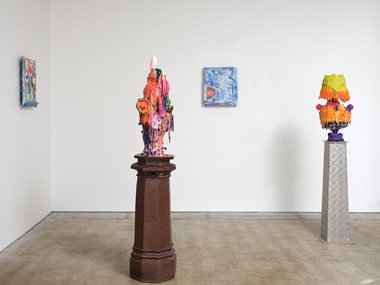John Hurrell – 25 February, 2023
They mentally provoke, for what has made that bizarre shape we detect lurking underneath, for our eyes can ‘feel' its surface? What produces that ominous bulge, those swelling bulbous growths, that line of wormy blips, those spidery crevasses? We can't scrape away their tops with a pocket-knife so we have to guess: ponder the probable sequence of stratification; speculate on what is cunningly positioned; what is accidental too—but still embraced.
Cat Fooks is a painter I suspect is paradoxically known for her love of glossy saturated colour loosely applied onto freestanding sculpture made from unpredictable part combinations of found objects, rather than on planar rectangles (which in her case are wonky with lumpy surfaces: pale and rainbow sprayed) that end up suspended from walls.
Though she makes plenty of those, I’d argue that the more colour-saturated sculptures (not including the flat table-top ‘shrines’) have more of a presence. To be able to move around them—and see all sides—is more thrilling. And gutsier, being more domestically and spatially disruptive. As vertical ‘columns’ they are a nuisance for hoovering or dusting, but oh so glorious as contributors to the interior architectural environs.
The part combinations originate from bits of furniture, toys, containers, lamps, bric-a-brac or knick-knacks she has joined up, squirted rippling gunk upon, poured copious colours on, or lined with the squeezed out contents of tubes of solidifying additives. Wildly weird, richly textured assemblages covered with restless coats of varied streaming chroma. Domestic in scale, they have an intimacy with their densely layered agitated surfaces that draw you in.
For this show, the title (Terebella) comes from a type of burrowing worm (with long tentacles for grabbing edible items that float by) that lives in crevices or holes on the sea bed. I guess Fooks sees herself as an opportunistic scavenger, quick to utilise anything she chances upon to create form. She doesn’t really have to vigorously search. Stuff always turns up. It finds her.
This process of Fooks‘ compulsively blending disparate object parts, and manically coating them, is what intrigues—especially when we are looking at the surfaces rather than through them. However, we also look through them (the outer ‘skins’) in our imagination, not only investigate in an ocular fashion.
They mentally provoke, for what has made that bizarre shape we detect lurking underneath—our eyes can ‘feel’ its surface? What produces that ominous bulge, those swelling bulbous growths, that line of wormy blips, those spidery crevasses? We can’t scrape away their tops with a pocket-knife so we have to guess: we ponder the probable sequence of stratification; speculate on what is cunningly positioned; what is accidental too—but still embraced.
Is there a hidden story here about material production that is worth listening to? Or is it a studio-based, process-oriented account that is better ignored? Is that thought itself better ignored? Can wilful ignorance help our vision, for maybe the experiential in isolation (free of narrative-wrapped time) can increase pleasure? A more intense, less communal quality of looking could be a reason why we would want to amplify our vision. A twisting, looping, wormlike, introspective inspection that dives headlong into private interiority and the immediate bombarding sensations of ‘now’.
John Hurrell












 Advertising in this column
Advertising in this column Two Rooms presents a program of residencies and projects
Two Rooms presents a program of residencies and projects



This Discussion has 0 comments.
Comment
Participate
Register to Participate.
Sign in
Sign in to an existing account.